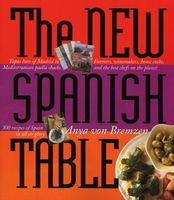Save 25% on ckbk Premium Membership with code FALLFLAVORS 🍁
Soups
From Cozy to Cool
Published 2005

Juan Mari Arzak and his daughter Elena in the kitchen of their three-star Restaurante Arzak in San Sebastián. Top right: Peppers, here drying on a string, will add a touch of color and flavor to many Spanish dishes. Bottom left: Cadaques, the idyllic whitewashed resort on Catalonia’s Costa Brava, is a longtime favorite vacation spot for artists. Bottom right: Crusty bread, fresh every day, makes just the right accompaniment to soup.
I encountered Iberian soup in its most basic form while cooking one afternoon with a group of grandmothers in the Catalan village of Sils. One of them grabbed half a loaf of stale bread and crumbled it into a pot. She added water; she tossed in a few mint leaves. Intently and patiently, she stirred the soup with a long wooden stick until the bread all but dissolved into the liquid, swelling and forming a porridge. “Sopa de menta cura la venta” (mint soup cures the stomach), she intoned, swirling an egg into the soup to thicken it. Then she splashed in some olive oil. Basta. Maybe it was the taste of the good country loaf or the special aroma of the freshly pressed oil. Or was it the fact that the egg had been laid just that morning? No matter which, four simple ingredients added up to one of the most deliciously nourishing things I can remember—a taste I have never been able to replicate in my own kitchen. Spanish cuisine is full of such miracles.
Become a Premium Member to access this page
Unlimited, ad-free access to hundreds of the world’s best cookbooks
Over 160,000 recipes with thousands more added every month
Recommended by leading chefs and food writers
Powerful search filters to match your tastes
Create collections and add reviews or private notes to any recipe
Swipe to browse each cookbook from cover-to-cover
Manage your subscription via the My Membership page
Monthly plan
Annual plan
In this section
Advertisement
Advertisement


